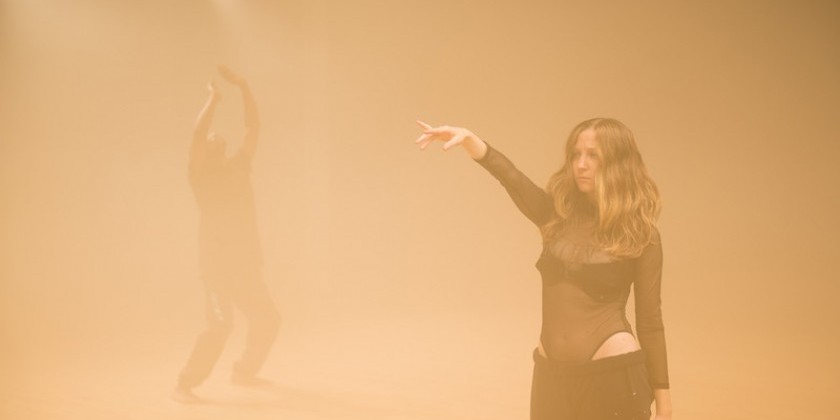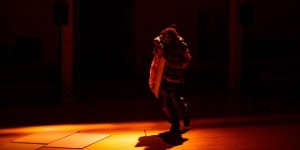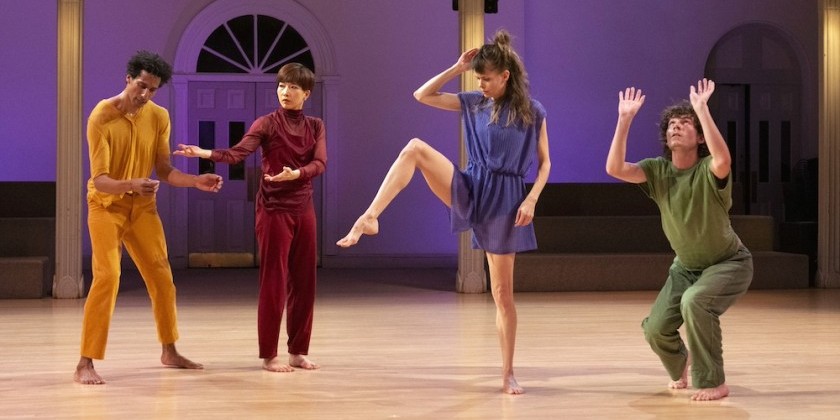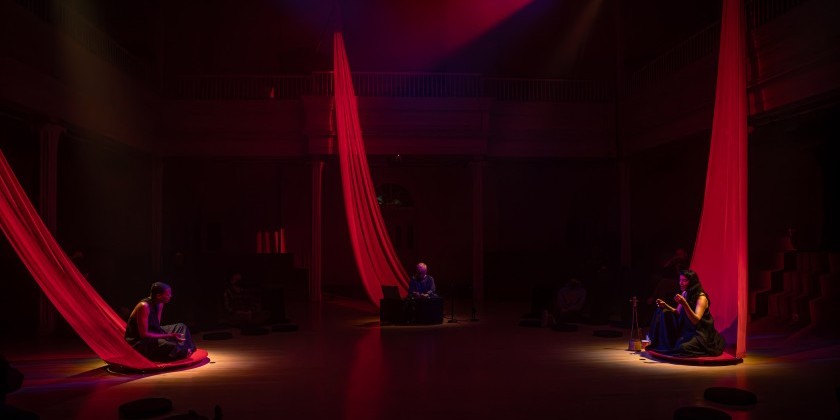IMPRESSIONS: Gillian Walsh’s "Moon Fate Sin" at Danspace Project

Creation: Gillian Walsh with Emily Hoffman
Performance: Maggie Cloud, Emily Hoffman, Justin Hyacinth, Mickey Mahar, and Gillian Walsh
Sound: Wally Blanchard, Gillian Walsh, and Neal Medlyn
Costumes: earth_trauma
Lighting: Carol Mullins
If the world is a stage, then the sun and the moon act as our spotlights. Their eternal cycle of rising, setting, and rising again illuminate our lives. Like bit players, their presence can remain unnoticed as we absorb ourselves in daily dramas. Yet, without light ritualizing every day, every week, every year, our actions, both big and small, would lose significance, maybe become nonexistent.
Light — and its negative expression, dark — takes center stage in Gillian Walsh’s Moon Fate Sin*, which was presented by Danspace Project and Performa 17. Like a sorceress, lighting designer Carol Mullins conjures a golden haze that settles atop the dance floor of St. Mark’s Church-in-the-Bowery. Incrementally whitening and blackening, this spun-from-stars luminescence shrouds the piece in transcendent splendor.
Opening in media res, Maggie Cloud, Emily Hoffman, and Justin Hyacinth anchor the dance floor while Mickey Mahar is stationed in the balcony. Walsh, who’s listed as a performer, might be up there or somewhere else entirely. I can’t locate her as the audience is sprawled around three sides of the space, the show we see dictated by our chance choice of seat.

Against a droning soundscape, the dancers purposefully plié in voluminous second positions, their arms gliding from high to low, from open to closed. They assume yoga poses — a cobra, a downward dog — to suggest a rite of physical reverence. While each performs an independent score, occasional and likely accidental moments of cohesion emerge. When Cloud and Maher lunge in profile, it feels revelatory, like their bodies are twin compasses pointing to a future only they understand.
The work exudes feminine energy. Smudgy in their shape, dancers kneel and crumple to the floor — supplicants to Mother Earth. Their centers maintain serenity, confidence, fortitude, born, perhaps, of their communal enterprise that’s non-hierarchal in intent and execution.

Each contributor personalizes the movement sacraments. Cloud is ethereal as she lifts a leg in an arabesque, her wrists and feet curving delicately — petals of a calla lily. Taut and sword-like, Hyacinth’s arms carve through the burnished mist. Maher, bare-chested with his lower body concealed by the railing, registers as a warrior glimpsed from afar.
For all its mystical beauty, Moon Fate Sin, from start to finish, shows no change, no arc, and no momentum. Less a dance and more a moving painting, the work fades to insignificance the longer it unspools statically. Watching it is like hanging out in a sunlit garden, wishing the flowers would grow.
*The program describes Moon Fate Sin as a book, a dance, and a tape. The book and the tape were available for purchase after the show. This review speaks only to the dance.
The Dance Enthusiast Shares IMPRESSIONS/ our brand of review and Creates Conversation.
For more IMPRESSIONS, click here.
Share your #AudienceReview of this show or others for a chance to win a prize.













